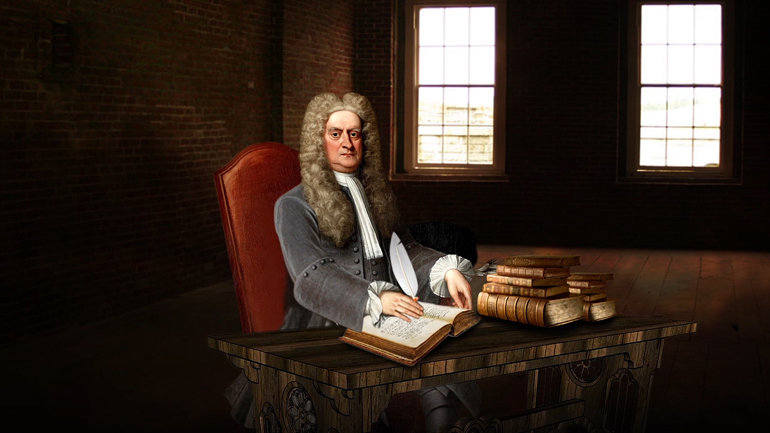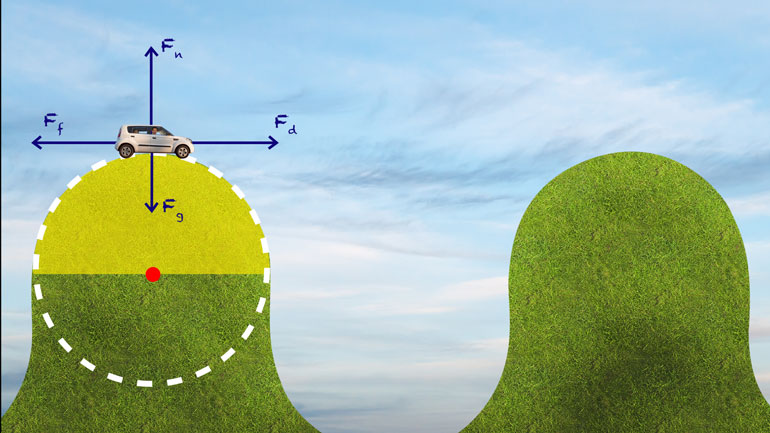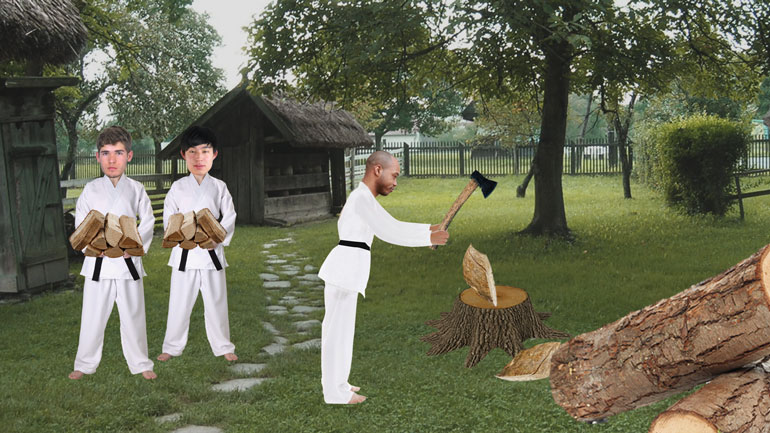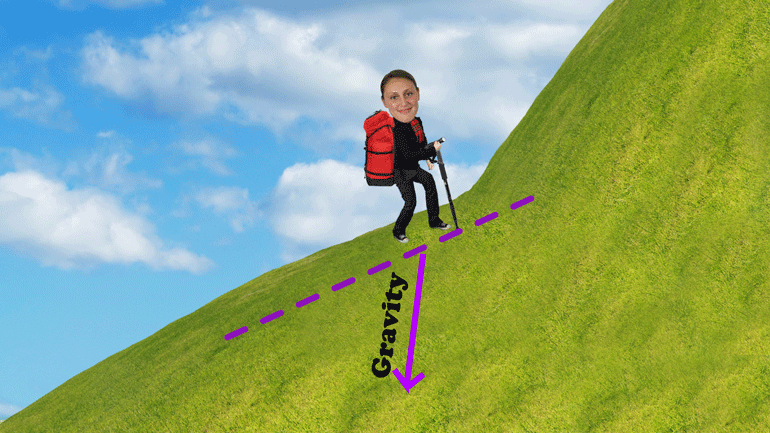ShmoopTube
Where Monty Python meets your 10th grade teacher.
Search Thousands of Shmoop Videos
Physics Videos 34 videos
Isaac Newton. Who was he? Why do we need to know about him? In a physics course, no less? Well, he's only the most famous physicist in history, and...
What are the basics of trigonometry? And why are we learning about this in a physics course? Both good questions. In this video, you'll learn about...
It's time to make our liters and meters work together. Enough of the bickering, right? In this video, we'll do some unit analysis, covering SI Unit...
Physics: Balanced Force Equations 13 Views
Share It!
Description:
Balanced force equations: the zen of Newton.
Transcript
- 00:00
smell all right balanced force equations the Zen of Newton
- 00:09
okay constant velocity equals balanced forces be Fe for RF Metis was that [bullet points on blackboard]
- 00:17
related to be FG he's a nice guy and okay clapper gum did you do them getting
- 00:23
angular yeah inclined to use more trig blah blah blah maybe do some mix
- 00:32
stretches yeah good stretching is necessary okay it's important to have [woman walking tight rope]
Full Transcript
- 00:39
balance in your life balance mind so you don't get too obsessed over stuff like [woman napping on her books]
- 00:43
physics a sense of balance so we're not falling down all the time and a balanced [model falls on cat walk]
- 00:48
breakfast it turns out that eating three bowls of Lucky Charms doesn't actually [woman pouring cereal]
- 00:52
set you up for a successful day and we know that balance is a big part of
- 00:57
physics too when we're dealing with constant velocity whether the velocity [woman on tight rope]
- 01:01
is positive negative or non-existent we know that we have balanced forces
- 01:06
whenever we have balanced forces we can set up balanced force equations in a [black board]
- 01:12
balance force equation we break down all the forces acting on an object to their
- 01:18
X&Y components then we can set up formulas showing that the force is
- 01:23
pointing to the left are equal to the forces pointing to the right and that
- 01:28
the force is pointing up are equal to the forces pointing down again this only
- 01:33
works when we don't have any acceleration happening if the velocity
- 01:37
is changing then we know we're dealing with unbalanced forces and all of this
- 01:43
balanced equation stuff goes out the window for now we're not going to put [man flies paper airplane]
- 01:47
any numbers into these equations it's more important to understand how these
- 01:52
equations get set up besides we're pretty sure you can do the actual math
- 01:57
when the time comes and we will run through one problem with actual numbers
- 02:01
at the end of the lesson once we do have magnitudes to work with we should still [kid sitting at desk]
- 02:06
set up the equations first before we start dealing with the values it'll help
- 02:11
keep things nice neat we like nice and neat especially
- 02:14
when it comes to math let's start off with something pretty simple your
- 02:19
average everyday Bulldog pushing a kid in a stroller we're sure you have [dog pushing stroller in park]
- 02:23
neighbors like these near you the stroller is moving at a constant
- 02:27
velocity from right to left so what does this tell us about the forces that are [stroller rolls past metal bars]
- 02:32
acting on the stroller let's look at this Freebody diagram first we'll draw
- 02:38
the line for the ground the square here will represent the stroller now let's
- 02:42
think about what's going on for one thing we know we've got a slobbering [bulldog in park]
- 02:47
pooch providing applied acceleration in this direction we call that vector F sub
- 02:53
a and any time we have motion we know we've got friction acting in the
- 02:58
opposite direction let's mark that F sub F and since the stroller isn't picking
- 03:03
up speed careening faster and faster down the sidewalk until it all ends in a [stroller crashes against building]
- 03:08
fury crash we know those forces must be balanced so to write it as an equation
- 03:13
we can say that F sub a equals F sub F as always we've got gravity acting on
- 03:20
the stroller to which is the F sub G vector here and the ground is providing
- 03:26
an upwards normal force F sub n so we can say that F sub G equals F sub n but
- 03:34
we can break down a little further we know that F sub G represents the weight [man punches board into two]
- 03:39
of the stroller weight equals mass times gravity and since F sub n equals F sub G [numbers on black board]
- 03:46
the normal force also equals mass times gravity so if we're given the mass of
- 03:53
the stroller we could figure out the normal force by plugging in the
- 03:57
acceleration of gravity easy peasy when we've got balanced forces acting in
- 04:02
perpendicular directions it's not too hard to figure out our equations but
- 04:07
things get a little bit trickier when we start adding angles into the mix let's
- 04:12
talk about the time the circus clowns had a little party after a show [clowns partying]
- 04:16
things got pretty out of hand and when we came into the big top the next
- 04:20
morning there were passed out clowns like everywhere we had to drag these [clowns passed out on floor]
- 04:24
goofballs by their hair to get them to their trailers we'll say we're providing [woman drags clown away]
- 04:29
a constant velocity from left to right let's draw an FBD of this situation to
- 04:34
figure out what forces are active will draw the clown as a square so we don't
- 04:38
have to look at his painted face and have nightmares [black and white picture of clown face]
- 04:41
we'll start with gravity F sub G and the normal force F sub n pretty
- 04:46
straightforward so far our motion is going this way so we know we've got
- 04:51
friction going the other way we'll add that in and call it F sub F what about
- 04:56
the force in the direction of motion though like we said we're pulling this [woman pulling clown across floor]
- 05:00
bozo by the hair meaning we're holding him at an angle
- 05:03
and the force is really a tension force yeah it turns out the big red pouf isn't
- 05:09
a wig it's the real deal so that force is at an angle we'll call that F sub T
- 05:15
pen draw it like this hmmm S sub T can't balance friction
- 05:20
because it's not in the same direction but using the X and y directions as the
- 05:26
other two sides of a right triangle means that we can find the components of
- 05:31
the triangle we just made we'll tackle the X Direction ie the horizontal first
- 05:36
now theoretically we could just say that F sub F equals F sub TX but that
- 05:43
wouldn't be really helpful would it if this was a real experimental situation [woman continues to drag clown across floor with doctor watching]
- 05:48
we would be able to measure the force being applied by F sub T so let's figure
- 05:53
out how to really solve for F sub TX and we can do that with something called [numbers on black board]
- 05:58
trigonometry our angle of incline is this one right here will Papa theta on
- 06:05
that going back to our trig functions which is the right one to find this side
- 06:10
well if we use our old mnemonic sohcahtoa we know that the sine of an
- 06:16
angle equals the opposite side over the hypotenuse the cosine of an angle equals
- 06:22
the adjacent side over the hypotenuse and the tangent equals the opposite over
- 06:27
the adjacent like we said in this experiment we'd be
- 06:31
able to know the tension force which is the hypotenuse of the triangle and the
- 06:36
horizontal side would be the adjacent of our theta angle so the right function is
- 06:42
cosine and if the cosine of theta equals f sub t x over F sub t then we can
- 06:50
rearrange the equation to solve for f sub t X to do that we multiply both
- 06:56
sides by the hypotenuse F sub T so f sub TX equals F sub x the cosine of theta
- 07:05
and F sub F equals the same thing - it's all about maintaining balance am i right
- 07:12
as for f sub T Y it would be the same process for that but we'd used the sine
- 07:18
function instead of cosine we'd multiply both sides by F sub T to find that X sub
- 07:24
T y equals F sub T times sine theta taking another look at our diagram we
- 07:31
see two upward arrows F sub n and F sub T Y and the downward arrow F sub G since
- 07:39
there's no acceleration vertically we know that these forces have to be
- 07:42
balanced which means that F sub G equals F sub n plus F sub T why what does F sub
- 07:51
G equal it equals mass times the acceleration of gravity so we can put
- 07:58
that in place of F sub G now let's get really crazy what if we have a lion that
- 08:05
escaped from his cage and is sitting on one of the acrobats seesaws you see [lion on see-saw with lion trainer holding chair]
- 08:09
Pedro easy there here's what the Freebody diagram would look like we've
- 08:15
got our ramp here and gravity is always going straight down the normal force is
- 08:19
perpendicular to the surface of the incline and friction is acting in the
- 08:24
direction up the ramp we know that because otherwise is cutley ferocious
- 08:28
beast but be sliding down the incline since he's staying still friction must [lion filing claws on rock]
- 08:33
be holding him in place so here we have one completely vertical line and two
- 08:39
agonal lines we could find the components for F sub N and F sub F but
- 08:44
that would involve a lot of trig we like doing as little trig as possible so what
- 08:49
have we take a moment to warm up maybe crack our neck a couple of times and
- 08:51
look at this inclined from a tilt here we'll save you from any injury risk and
- 08:56
do the tilting for you okay that change of perspective makes things a little
- 09:00
easier now we've got a diagonal line instead of two that cuts the amount of
- 09:05
trig we need to do by half now we can draw the vector F sub GX parallel to the
- 09:11
incline and the wide component perpendicular to the incline now we can
- 09:17
set up our balanced forces equation like so in the x-direction we have F sub F
- 09:24
equal to F sub G X and in the Y direction that would be F sub N equals F
- 09:32
sub G Y but when we're dealing with actual numbers that's not gonna give us
- 09:36
everything we need if we're trying to figure out exactly how much the normal
- 09:40
force is we're not going to be able to just say oh it's equal to F sub G Y that [people in a meeting]
- 09:45
would be like saying like oh it's equal to purple it doesn't actually mean
- 09:49
anything yet because F sub G y is just some line we drew we need to put it in
- 09:54
terms of F sub G if we know how F sub G Y relates to F sub G then we can just
- 10:01
weigh Pedro the lion measure the angle and we'll have our answer because if we [lion on see-saw]
- 10:07
know the length of one side of our triangle and the degrees of the non
- 10:11
90-degree angles we can use trig functions to figure out everything else
- 10:16
oh wait what angle are we talking about when we say to measure the angle we have
- 10:22
a known angle here that's the angle of the incline does that match with [woman gesticulating]
- 10:27
anything in this new triangle we drew well this hypotenuse is parallel with
- 10:32
the opposite side in the Triangle created by the seesaw and this part F
- 10:36
sub G is parallel with the hypotenuse of our
- 10:40
starting triangle remember the trig functions like sine and cosine are all
- 10:44
ratios so if an angle in a right triangle has a cosine of 0.5 that means
- 10:51
the hypotenuse is twice as long as the adjacent side it doesn't matter if the
- 10:56
hypotenuse is 2 meters and the adjacent side is 1 meter or if it's 80 meters for
- 11:01
the hypotenuse and the adjacent is 40 the ratio is the same so what does that
- 11:06
have to do with the whole lion situation we have here well in our mini triangle
- 11:11
that we made out of f sub G and it's XY components we have two sides that are
- 11:16
parallel to our big boy triangle since they're parallel that means their ratio
- 11:22
must be the same as the corresponding sides of our big boar triangle so this
- 11:27
angle here we'll call it a must be equal to the angle where the parallel sides of
- 11:33
the triangle meet like bad this one right here will give it a really big a
- 11:39
to match and since the three angles of a triangle add up to 180 degrees and we
- 11:45
know two of the angles and each triangle are equal to each other that means the
- 11:50
last angle in the triangles have to be equal to since we know our angle of
- 11:54
incline at least theoretically we know that this angle at the top of
- 11:58
the mini-me triangle also equals theta whoo all this trick makes juggling while
- 12:04
riding a unicycle on a tightrope look easy so now we can use our sine and [woman juggling while riding a unicycle on a tightrope]
- 12:09
cosine functions to put the component vectors for gravity in terms of F sub G
- 12:15
sine of theta equals F sub G x over F sub G when we rearrange to solve for F
- 12:23
sub G X we find that it equals F sub G times sine theta as for gravity on the
- 12:30
y-axis we'll use cosine cosine of theta equals F sub G Y over F sub G which is
- 12:37
once again rearrange to solve for F sub G Y F sub G y equals F sub G times the
- 12:44
cosine of theta now put all of this into our balance force equation
- 12:49
F sub n equals F sub G y we know that F sub n also equals F sub G times cosine
- 12:57
beta last step Sub out F sub G for mass times gravity
- 13:03
soo F sub n equals mass times gravity times cosine theta why is this important
- 13:11
it's important because if we can weigh our Lian and find the angle of the [lion on a scale then man measures see-saw]
- 13:16
incline we can figure out the force of friction and the normal force yep just a
- 13:22
scale and a protractor and we can find the forces of the universe well a couple [picture of galaxy]
- 13:27
of them at least pretty cool right let's look at one more problem and actually [woman juggling]
- 13:31
use some numbers this time one of our clown's biffo has shaken off that rough [clown rides bike up platform]
- 13:36
night and is biking up a ramp to a diving platform he's going to do one
- 13:40
heck of a belly flop but let's figure out some stuff before he gets that far
- 13:45
we'll say he's exerting 900 Newton's of force to climb up this ramp which is at
- 13:50
a 35 degree angle bippo and his bike have a mass of 75 kilograms assuming
- 13:57
he's moving at a constant velocity what is the force of friction and the normal
- 14:02
force of the ramp okay here's our FB D whoa yikes three diagonal angles to deal
- 14:09
with okay let's do that whole tilty thing to make this problem easier okay
- 14:14
much better now we just have one diagonal to deal with we'll sketch in
- 14:18
the X and y components of gravity and like we just saw before our known angle
- 14:24
theta will go at the top here as the angle between F sub G and F sub G Y
- 14:29
Biffle is moving at the same speed so there's no positive or negative
- 14:33
acceleration so the two vectors pointing backwards from bibo add up to equal the
- 14:39
vector in the direction of his motion F sub F plus F sub GX equals F
- 14:47
a we want to solve for F sub F so we can subtract F sub G X from both sides to
- 14:55
isolate our target oh yeah now we're making progress there's no acceleration
- 15:00
along the y axis either so the arrows along that plane are also equal F sub n
- 15:06
equals F sub G Y sticking with this vertical stuff
- 15:10
let's get F sub G Y into terms of X sub G like we said previously the cosine of [stock market on market street screens]
- 15:17
theta equals F sub G Y over F sub G rearranging that to solve for F sub G Y [numbers on black board]
- 15:24
shows that it equals F sub G times cosine of theta one last step before we
- 15:30
start putting in the numbers let's swap F sub G for mass times gravity after all
- 15:36
they're the same thing so the normal force equals mass times gravity times
- 15:41
the cosine of theta all right number time in case you forgot Pipo and his
- 15:47
bike have a mass of 75 kilograms and the theta is 35 degrees gravity is the same
- 15:53
old 9.8 m/s^2 so the normal force equals 75 kilograms
- 15:59
times 9.8 meters per second squared times cosine of 35 degrees when we
- 16:06
multiply all those together we find a force of about 602 Newton's or 6.0 times
- 16:14
10 to the 2nd to follow the significant figures rules
- 16:18
look at those clown legs pump away little bit I'll go okay onto the [clown riding bike up ramp]
- 16:24
x-direction to find our friction we've already figured out that the force of
- 16:28
friction equals the applied force minus the X component of gravity let's get
- 16:34
that X component into terms of F sub G will use sign for that sine theta equals
- 16:40
F sub G x over F sub G solving for F sub G X we can rearrange the equation so
- 16:47
that F sub G X equals F sub G times sine theta okay we'll put that into the
- 16:54
balanced force equation we have for F sub
- 16:57
F sub F equals F sub a minus F sub G times sine theta and just like we did in
- 17:05
the y-direction we can step out F sub G for mass and gravity biffo is applying
- 17:11
900 Newton's of force on his way to the diving platform so when we plug in the
- 17:17
number our equation looks like this F sub F equals 900 Newton's minus the
- 17:23
product of 75 kilos times 9.8 meters per second squared times the sine of 35
- 17:29
degrees our calculator tells us that the force of friction equals four hundred
- 17:35
seventy eight point four Newton's using the right number of sig figs which in
- 17:39
this case is two gives us a result of four point eight times ten to the second
- 17:44
Newtons after all this your belly-flop had [clown falls off ramp into pool]
- 17:48
better be worth it clown okay okay not bad fellas thing seems pretty easy when
- 17:53
you're just standing on flat ground but once you start adding other forces or
- 17:57
angles or flaming torches balancing can get a lot more complicated just remember [woman juggles flaming torches while riding unicycle on tightrope]
- 18:03
to take everything step by step and set up your equations before you start
- 18:07
worrying about any actual numbers and even if you make a wrong step and lose [woman walking on tight rope then falls]
- 18:12
your balance it's okay you have the luxury of being able to start over again
- 18:17
as for us well because hope a clown will break our fall [woman falls on clown]
Related Videos
When you're about to marry the love of your life, not many things could stop you. However, finding out that your future hubby is keeping his crazy...
Here at Shmoop, we work for kids, not just the bottom line. Founded by David Siminoff and his wife Ellen Siminoff, Shmoop was originally conceived...
ACT Math: Elementary Algebra Drill 4, Problem 5. What is the solution to the problem shown?
AP® English Literature and Composition Passage Drill 1, Problem 1. Which literary device is used in lines 31 to 37?
AP® English Literature and Composition Passage Drill 2, Problem 1. What claim does Bacon make that contradicts the maxim "Whatsoever is delig...






































